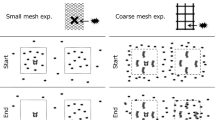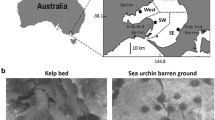Abstract
We studied the effects of grazing by two species of sea urchins on two species of kelp (Macrocystis pyrifera and Pterygophora californica) in the San Onofre kelp bed in southern California from 1978 through 1981. Both red sea urchins, Strongylocentrotus franciscanus, and white sea urchins, Lytechinus anamesus, were abundant and lived in aggregations. The purple sea urchin (S. purpuratus) was rare at the study site and was not studied. The aggregations of red urchins were either relatively small and stationary (for over 3 yr) or relatively large and motile (advancing at about 2 m mo−1). Both stationary and moving aggregations were observed at the same time, and within 100 m of one another. Stationary aggregations of red urchins probably subsisted mainly on drift kelp and had no effect on kelp recruitment or on adult kelp abundance. In contrast, red sea urchins in large, motile aggregations or “fronts” ate almost all the macroalgae in their path. The condition of their gonalds indicated that red urchins in fronts were starved relative to red urchins in the small, stationary aggregations. Large, motile aggregations developed after 2 yr of declining kelp abundance (probably due largely to storms). We propose that a scarcity of drift algae for food results in a change in the behavior pattern of the red urchins and thus leads to the formation of large, motile aggregations. The aggregations of white urchins, which occurred along the offshore margin of the kelp bed, were large, but relatively stationary. The white urchins rarely ate adult kelps, but grazed extensively on early developmental stages of kelps and evidently prevented seaward expansion of the bed. The spatial distribution of both types of red urchin aggregations appeared to be unrelated to predation pressure from fishes or lobsters.
Similar content being viewed by others
Literature cited
Breen, P. A. and K. H. Mann: Changing lobster abundance and the destruction of kelp beds by sea urchins. Mar. Biol. 34, 137–142 (1976a)
Breen, P. A. and K. H. Mann: Destructive grazing of kelp by sea urchins in Eastern Canada.J. Fish. Res. Bd Can. 33, 1278–1283 (1976b)
Chapman, A. R. O.: Stability of sea urchin dominated barren grounds following destructive grazing of kelp in St. Margaret's Bay, Eastern Canada. Mar. Biol. 62, 307–311 (1981)
Clark, M. E.: Dissolved free amino acids in sea water and their contribution to the nutrition of sea urchins. A. Rep. W. M. Keck Lab. envirl Hlth Engng Calif. Inst. Technol. Kelp Habitat Improvement Project 1968–1969, 70–92 (1969)
Cowen, R. K.: The effect of sheephead (Semicossyphus pulcher) predation on red sea urchin (Strongylocentrotus franciscanus) populations: an experimental analysis. Oecologia 58, 249–255 (1983)
Cowen, R. K., C. R. Agegian and M. S. Foster: The maintenance of community structure in a central California giant kelp forest. J. exp. mar. Biol. Ecol. 64, 189–201 (1982)
Dayton, P. K., V. Currie, T. Gerrodette, B. Keller, R. Rosenthal and D. V. Tresca: Patch dynamics and stability of Southern California kelp communites. Ecol. Monogr. (In press). (1983)
Duggins, D. O.: Kelp beds and sea otters: an experimental approach. Ecology 61, 447–453 (1980)
Ebert, T. A.: Negative growth and longevity in the purple sea urchin Strongylocentrotus purpuratus (Stimpson). Science, N.Y. 157, 557–558 (1967)
Fricke, A. H.: Kelp grazing by the common sea urchin, Parechinus angulosus Leske in False Bay, Cape. South African. J.Zool. 14, 143–148 (1979)
Jackson, G. A.: Nutrients and production of giant kelp, Macrocystis pyrifera, off Southern California. Limnol. Oceanogr. 22, 979–995 (1977)
Jones, N. S. and J. M. Kain: Subtidal algal colonization following the removal of Echinus. Helgoländer. wiss. Meeresunters. 15, 460–466 (1967)
Lawrence, J. M.: On the relationship between marine plants and sea urchins. Oecanogr. mar. Biol. A. Rev. 13, 213–286 (1975)
Lees, D. C. and G. A. Carter: The covering response to surge, sunlight and ultraviolet light in Lytechinus anamesus (Echinoidea). Ecology 53, 1127–1133 (1972)
Leighton, D. L.: Grazing activities of benthic invertebrates in Southern California kelp beds. Nova Hedwigia (Suppl.) 32, 421–453 (1971)
Lobban, C. S.: The growth and death of the Macrocystis sporophyte (Phaeophycea, Laminariales). Phycologia 17, 196–212 (1978)
Mattison, J. E., J. D. Trent, A. L. Shanks, T. B. Akin and J. S. Pearse: Movement and feeding activity of red sea urchins (Strongylocentrotus franciscanus) adjacent to a kelp forest. Mar. Biol. 39, 25–30 (1977)
North, W. J. and M. B. Schaefer: An investigation of the effects of discharged wastes on kelp. Publs Calif. St. Wat. Qual. Control Bd 26, 1–124 (1964)
Pearse, J. S., M. E. Clarke, D. L. Leighton, C. T. Mitchell and W. J. North: Size structure of urchin populations. A. Rep. W. M. Keck Lab. envrl Hlth Engng Calif. Inst. Technol. Kelp Habitat Improvement Project 1969–1970, Appendix (1970)
Pearse, J. S. and A. H. Hines: Expansion of a Central California kelp forest following the mass mortality of sea urchins. Mar. Biol. 51, 83–91 (1979)
Péquignat, E.: Some new data on skin-digestion and absorption in urchins and sea stars (Asterias and Henricia): Mar. Biol. 12, 28–41 (1972)
Reed, D. and M. Foster: The effect of canopy shading on algal recruitment and growth in a kelp forest. Ecology (In press). (1983)
Rosenthal, R. J., W. D. Clarke and P. K. Dayton: Ecology and natural history of a stand of giant kelp, Macrocystis pyrifera. J. Biogeogr. 6, 407–414 (1979)
Schiel, D. R.: Selective feeding by the echinoid, Evechinus chloroticus, and the removal of plants from subtidal algal stands in northern New Zealand. Oecologia 54, 379–388 (1982)
Tegner, M. J. and P. K. Dayton: Population structure, recruitment and mortality of two sea urchins (Strongylocentrotus franciscanus and S. purpuratus) in a kelp forest. Mar. Ecol. Prog. Ser. 5, 255–268 (1981)
Wilson, K. C., P. L. Haaker and D. A. Hanan: Kelp restoration in Southern California. In: The marine plant biomass of the Pacific Northwest coast, pp 183–202. Ed. by R. Krauss, Corvallis, Oregon: Oregon State University Press 1978
Author information
Authors and Affiliations
Additional information
Communicated by N. D. Holland, La Jolla
Please address all requests for reprints to the senior author at his present address.
Rights and permissions
About this article
Cite this article
Dean, T.A., Schroeter, S.C. & Dixon, J.D. Effects of grazing by two species of sea urchins (Strongylocentrotus franciscanus and Lytechinus anamesus) on recruitment and survival of two species of kelp (Macrocystis pyrifera and Pterygophora californica). Marine Biology 78, 301–313 (1984). https://doi.org/10.1007/BF00393016
Accepted:
Issue Date:
DOI: https://doi.org/10.1007/BF00393016




